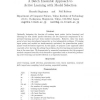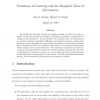1134 search results - page 148 / 227 » Sequential Inductive Learning |
PKDD
2010
Springer
14 years 7 months ago
2010
Springer
Active learning [1] is a branch of Machine Learning in which the learning algorithm, instead of being directly provided with pairs of problem instances and their solutions (their l...
NN
2008
Springer
14 years 10 months ago
2008
Springer
Optimally designing the location of training input points (active learning) and choosing the best model (model selection) are two important components of supervised learning and h...
CORR
2007
Springer
14 years 10 months ago
2007
Springer
Data mining allows the exploration of sequences of phenomena, whereas one usually tends to focus on isolated phenomena or on the relation between two phenomena. It offers invaluab...
AIED
2009
Springer
14 years 7 months ago
2009
Springer
In previous works, we showed how sequential pattern mining can be used to extract a partial problem space from logged user interactions for a procedural and ill-defined domain wher...
DA
2010
14 years 6 months ago
2010
We consider the Bayesian ranking and selection problem, in which one wishes to allocate an information collection budget as efficiently as possible to choose the best among severa...


